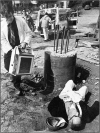Evolution of out-of-hospital emergency cardiac care: Heart attack therapy for a retired president helped modernize American emergency medical services
- PMID: 31191158
- PMCID: PMC6541094
- DOI: 10.1080/08998280.2019.1576014
Evolution of out-of-hospital emergency cardiac care: Heart attack therapy for a retired president helped modernize American emergency medical services
Abstract
In the late 1960s, American emergency medical services (EMS) began to upgrade from mere Red Cross first aid to systems that now provide sophisticated advanced life support. This revolution in EMS stemmed from two pioneering Belfast reports in The Lancet that described how early out-of-hospital coronary care saved lives. Inspired, a handful of American physicians implemented avant-garde programs in the USA. One such physician, Richard Crampton of the University of Virginia, supported by the university and by Charlottesville-Albemarle Rescue Squad staffs, led an early effort to provide out-of-hospital drug treatment and defibrillation via a mobile coronary care unit (MCCU) ambulance. Half a dozen high-profile local cases, including successful treatment of retired President Lyndon B. Johnson, demonstrated MCCU efficacy to the Virginia and American public via local and national press coverage. The economic feasibility of the MCCU system was established. With two Virginia colleagues, Crampton successfully lobbied for a bill to permit trained nonphysicians to render out-of-hospital cardiac care with no on-site physician. This MCCU-augmented EMS system reduced coronary deaths in Charlottesville and Albemarle County, Virginia. It also stimulated nationwide progress in care by EMS systems that yielded countless lives saved in the succeeding half-century.
Keywords: Charlottesville; Lyndon Baines Johnson; University of Virginia; emergency medicine; mobile coronary care unit.
Figures



Similar articles
-
Emergency medical services and sudden cardiac arrest: the "chain of survival" concept.Annu Rev Public Health. 1993;14:313-33. doi: 10.1146/annurev.pu.14.050193.001525. Annu Rev Public Health. 1993. PMID: 8323592 Review.
-
The revolution and evolution of prehospital cardiac care.Arch Intern Med. 1996 Aug 12-26;156(15):1611-9. Arch Intern Med. 1996. PMID: 8694658 Review.
-
Establishing a mobile coronary care service in a rural setting.Ir Med J. 2000 Sep;93(6):178-80. Ir Med J. 2000. PMID: 11105442
-
Role of the physician in prehospital management of trauma: North American perspective.Curr Opin Crit Care. 2002 Dec;8(6):551-8. doi: 10.1097/00075198-200212000-00012. Curr Opin Crit Care. 2002. PMID: 12454541
-
The mobile coronary care unit and the decision to seek medical care during acute episodes of coronary artery disease.Med Care. 1980 Mar;18(3):297-318. doi: 10.1097/00005650-198003000-00005. Med Care. 1980. PMID: 7366259
References
-
- Pantridge JF, Geddes JS. Cardiac arrest after myocardial infarction. Lancet. 1966;1:807–808. - PubMed
-
- Pantridge JF, Geddes JS. A mobile intensive-care unit in the management of myocardial infarction. Lancet. 1967;2:271–273. - PubMed
-
- Hirschman JC, Nagel EL. Prehospital mobile emergency care in Miami, Florida. An historical commentary. J Fla Med Assoc. 1981;68:624–634. - PubMed
-
- Eisenberg MS. Life in the Balance: Emergency Medicine and the Quest to Reverse Sudden Death. New York, NY: Oxford University Press; 1997.
-
- Crampton RS, Stillerman R, Gascho JA, et al. . Prehospital coronary care in Charlottesville and Albermarle county. Va Med Mon (1918). 1972;99:1191–1196. - PubMed
LinkOut - more resources
Full Text Sources
